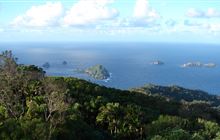Defence Force taking scientists and supplies to Kermadecs
Archived content: This media release was accurate on the date of publication.
Introduction
Scientific work in the Kermadecs, including studies on whales and the impact of the myrtle rust disease, will get a boost this week.Date: 21 September 2017 Source: New Zealand Defence Force and Department of Conservation
Scientific work in the Kermadecs, including studies on whales and the impact of the myrtle rust disease, will get a boost this week when the New Zealand Defence Force (NZDF) transports 16 government staff and more than six tonnes of supplies to Raoul Island.
Captain Dave McEwan, the Acting Maritime Component Commander, said the Royal New Zealand Navy Offshore Patrol Vessel HMNZS Wellington and an embarked Seasprite SH-2G(I) helicopter left Devonport today to carry out the NZDF’s second resupply mission to Raoul Island this year. They will return on 29 September.
“Our Defence Force has been supporting the work of other government agencies in the Kermadecs for years. Their work is important for our country’s biosecurity and public safety, and for scientific advancement,” Captain McEwan said.
Irene Middleton, DOC Senior Ranger for Raoul Island, said a researcher from the Sir Peter Blake Trust would be recording sightings of whales and dolphins and whale sound and taking DNA samples as part of a study by the University of Auckland.
“The information that will be collected will help us understand better the movements and connectivity of whales and dolphins in the South Pacific.”
Three biosecurity specialists from the agency would be conducting baseline monitoring to track the long-term effects of myrtle rust, the windborne fungal disease that has affected plants and trees in Northland and Taranaki, Ms Middleton said.
Myrtle rust was found on Raoul Island last March, just a month before the first cases were reported in mainland New Zealand. It has affected mainly pohutukawa and ramarama trees.
“The team will also conduct forest bird counts to assess if myrtle rust is affecting their survival, as pohutukawa trees are a food source,” Ms Middleton said.
A representative from the Ministry for Primary Industries will work alongside the DOC team to observe the impact of myrtle rust on New Zealand native species. They will also assess the decontamination process that is used for people going on and off the island.
Steve Knowles, MetService’s Network Observations Manager, said three MetService staff would carry out routine maintenance work on the automatic weather station on Raoul Island.
MetService staff would also train the DOC team on the safe use of hydrogen so they could release a hydrogen-filled weather balloon once a day. The meteorological data from the weather balloon was used to forecast global weather and to track tropical storms in the area, Mr Knowles said.
“NZDF’s support is vital to Raoul Island’s sub-tropical weather observation programme.”
GNS Science volcanologist Brad Scott said two technicians and three commercial divers from GNS Science would repair and update the tsunami gauges at Fishing Rock and Boat Cove on Raoul Island, which serve as New Zealand’s first line of defence against tsunamis.
“Data from the gauges are used to detect the threat of a tsunami after a large earthquake and are channelled to a national warning system managed by the Ministry of Civil Defence and Emergency Management,” Mr Scott said.
GNS staff would also check the earthquake sensors, two-way satellite ground station, volcano web camera and global positioning system equipment on the island, he said.
Contact
New Zealand Defence Force Public Affairs
Mobile: +64 21 487 980
Email: media@nzdf.mil.nz

